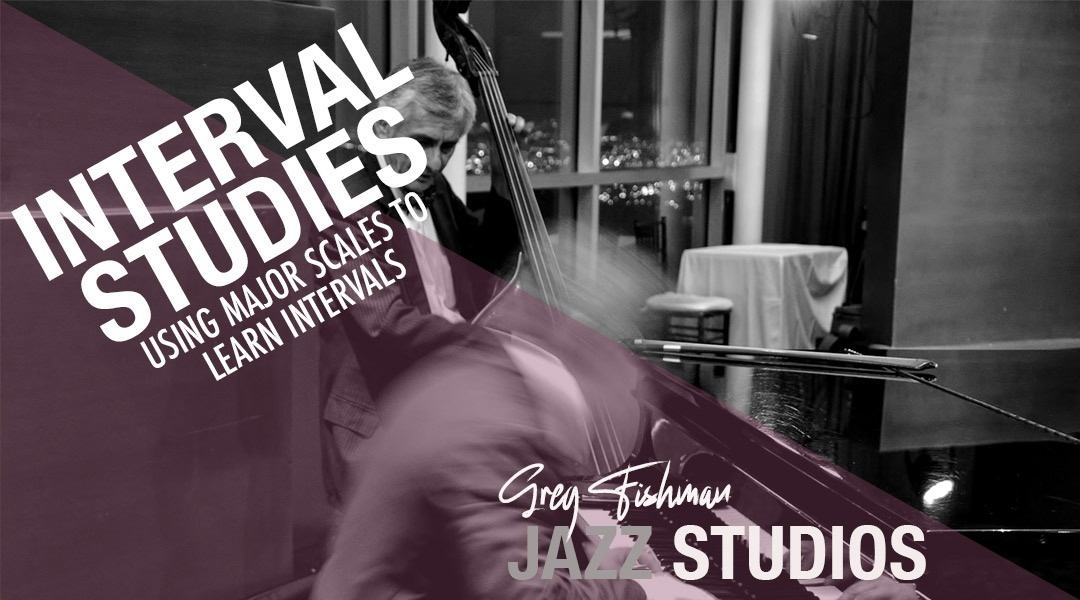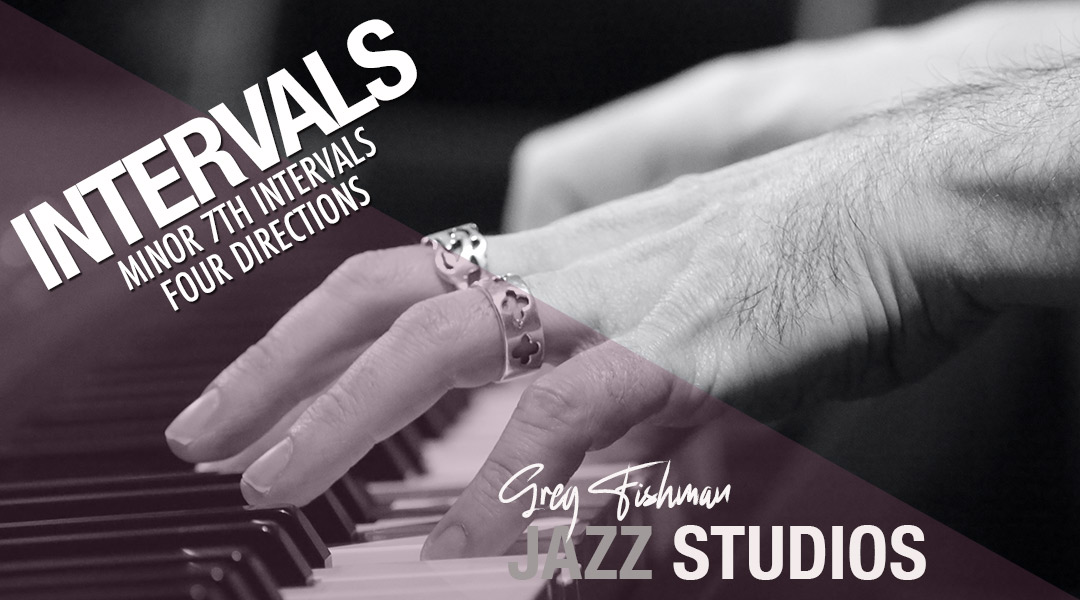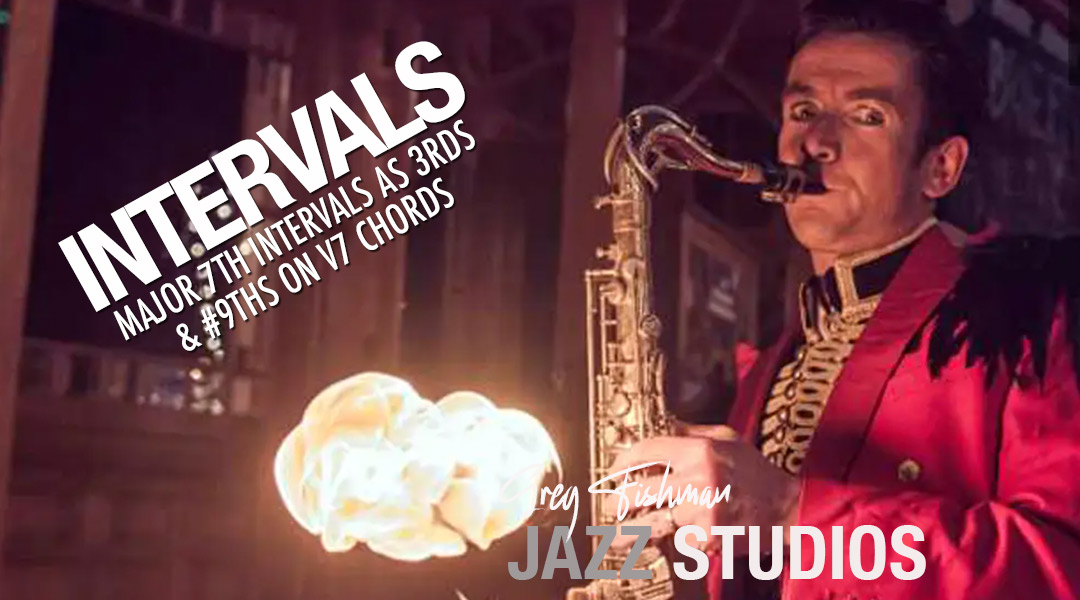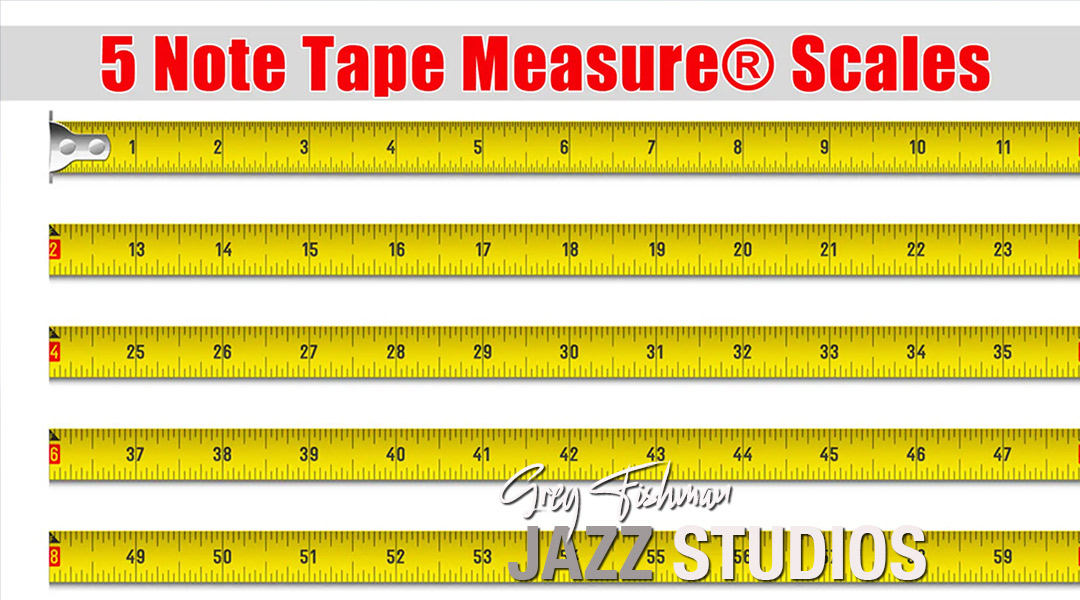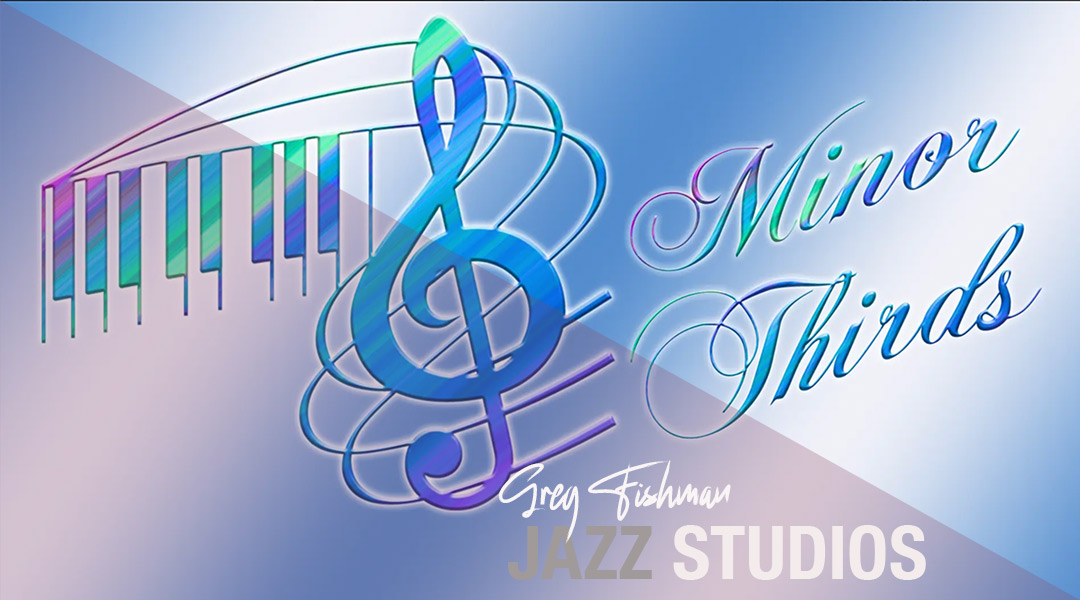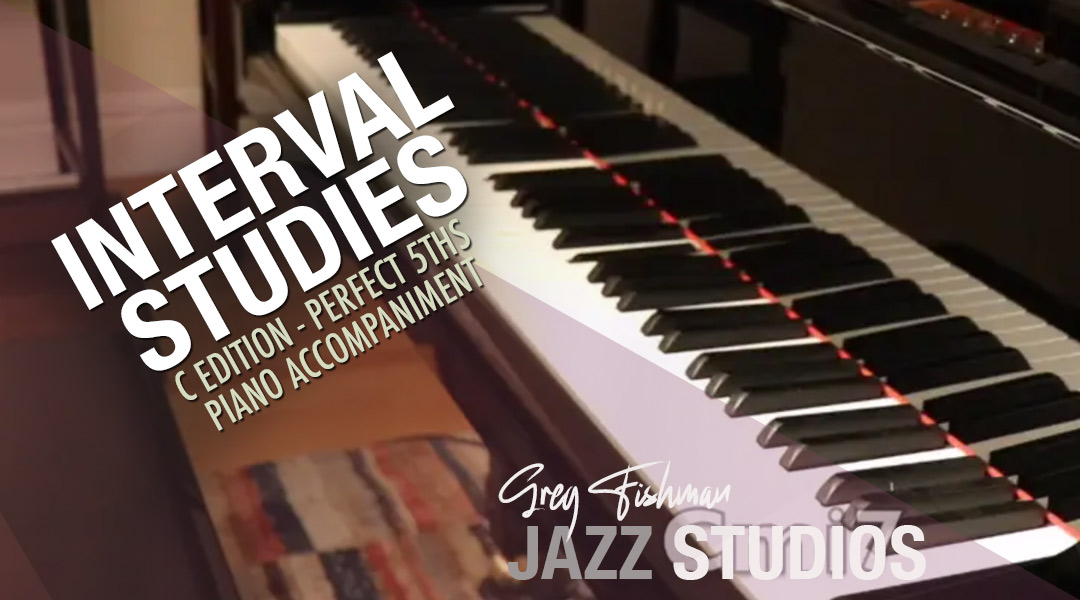Randomized Minor 3rds Echo Game
Mirrored Intervals
Mirrored Intervals
Using Major Scales to Learn Intervals
Using Major Scales to Learn Intervals
Interval Study – Major 7th intervals
Interval Study – Major 7th intervals
Minor 7th Intervals – Four Directions
Minor 7th Intervals – Four Directions
Major 7th Intervals as 3rds & #9ths on V7 Chords
Major 7th Intervals as 3rds & #9ths on V7 Chords
Major 6th Intervals – Four Directions
Major 6th Intervals – Four Directions
5 Note Tape Measure® Scales
5 Note Tape Measure® Scales
Minor 3rds Video Lesson – Intervals in Action
Minor 3rds Video Lesson – Intervals in Action
Major 2nd Video Lesson – Intervals in Action
Major 2nd Video Lesson – Intervals in Action
C Edition – Perfect 5ths – Piano Accompaniment
C Edition – Perfect 5ths – Piano Accompaniment
Eb Edition – Perfect 5ths Piano Accompaniment
Eb Edition – Perfect 5ths Piano Accompaniment
Randomized Minor 3rds Echo Game with the Vibes
Randomized Minor 3rds Echo Game
Mirrored Intervals
Mirrored Intervals
Using Major Scales to Learn Intervals
Using Major Scales to Learn Intervals
Interval Study – Major 7th intervals
Interval Study – Major 7th intervals
Minor 7th Intervals – Four Directions
Minor 7th Intervals – Four Directions
Major 7th Intervals as 3rds & #9ths on V7 Chords
Major 7th Intervals as 3rds & #9ths on V7 Chords
Major 6th Intervals – Four Directions
Major 6th Intervals – Four Directions
5 Note Tape Measure® Scales
5 Note Tape Measure® Scales
Minor 3rds Video Lesson – Intervals in Action
Minor 3rds Video Lesson – Intervals in Action
Major 2nd Video Lesson – Intervals in Action
Major 2nd Video Lesson – Intervals in Action
C Edition – Perfect 5ths – Piano Accompaniment
C Edition – Perfect 5ths – Piano Accompaniment
Eb Edition – Perfect 5ths Piano Accompaniment
Eb Edition – Perfect 5ths Piano Accompaniment
Module 51
LESSON 1: Randomized Minor 3rds Echo Game with the Vibes
In this video lesson, we’ll play the echo game with minor 3rds in the four directions, but also, they’re randomized.
This was one of my main ear-training strategies in my early 20s as I was developing my teaching method. It’s challenging but fun, and it will yield great results.
Why the vibes? The vibes provide a clear, bell-like tone that rings for a long time. I have found this to be excellent for helping players internalize the sounds of the pitches….The notes will still be ringing while you try to match the pitch.
This will allow your ear to compare the ringing pitch of the vibes with the sounds coming out of your horn, and you’ll learn to adjust to match the vibes very quickly.
LESSON 2: Cannonball Adderley: ii mi7- V7 – Melodic Genius Phrase
In this video lesson, I explore the opening phrase of Cannonball Adderley’s classic solo on Autumn Leaves. It’s a iimi7 – V7 phrase – Ami7 to D7 in alto key.
This is a masterpiece of melodic efficiency and beauty. Follow the video by ear and play along with me to learn this essential phrase of classic jazz vocabulary from Cannonball.
Includes PDF Practice notes for Bb, Eb and C instruments.
LESSON 3: Escaping the Conscious Mind of Theory
In this video, I share my thoughts about escaping the conscious mind of theory and playing at the speed of sound. Many aspiring players seem to only play as fast as they can mentally calculate the correct notes for a scale, chord, or phrase.
I’ve even encountered pro players who have come to me for help, telling me that they just can’t stop thinking about theory as they play. I used to play that way, but it was very limiting and musically frustrating.
However, I discovered that if I played very fast, my conscious mind couldn’t keep up and didn’t even try. This freed me up to focus on the sound I was hearing, as opposed to the theory I had been thinking.
Once I felt what it was like to play by ear, with my fingers responding to the sound, it felt like I had an aural awareness of the chords as I played (at any tempo), without having to think mechanically through the spellings and theory.
This is not to say that you don’t need to know music theory. You do need to know your scales and chord spellings but think about this in terms of spoken language…You’re not spelling out words in your mind and diagramming sentences while you have a fast conversation with a close friend.
The music should be the same way…you need to break free of those chord and scale spellings and play by sound (ear). Since this involves high-speed playing, I also discuss some of my concepts of hand and finger relaxation so that you can learn to play at high speeds without injuring your hands, wrists, and arms.
LESSON 4: Major 6/9 Chord Voicing with 4ths
I’ve had many questions from students about major 6/9 chords, versus C maj7 chords. In this video, I discuss the differences between the two chords, as well as the similarities.
This chord voicing utilizing 1-3-6-9 is a piano voicing that I like. It has a fresh, open sound when played on the saxophone, and it’s a nice contrast to hearing the more common chord voicings in thirds used by most saxophonists. Includes two echo games — one with maj7 and major 6/9 chords for your ear to compare the two sounds, followed by an echo game with just the new voicing.
Module 36
LESSON 1: Mirrored Intervals
In this video lesson, I share a concept that I call “mirrored intervals.” By this terminology, I’m referring to the sound of playing, let’s say, an E up to a G, and then playing the same E again, but dropping to the G below. The result is that you’ll go up a minor third and the “mirrored” interval produced when you drop down to the G below E will be a major sixth. One of my favorite players, Gene Ammons uses this device quite a bit in his solos. In this lesson, I’ll demonstrate several ways to practice this concept and get it into your playing. Intermediate & Advanced level. Includes detailed PDF practice notes for Bb, Eb and C instruments.
LESSON 2: Fixing the Break: How to play smoothly from C to D
One problem for many aspiring saxophonists is “the break,” which is the part of the horn that switches from the lower register, without the octave key, to the upper register, with the octave key. The break can be especially challenging when going from middle “C” to middle “D.” The thing that many aspiring players don’t realize is that while there’s just one key to press on the horn, there are actually two octave keys. One is located on the neck, and the other is located on the body of the horn. In this video lesson, I demonstrate both the problem and the solution. Includes close-up camera shots of my hands as I play the horn. If you’ve ever wanted to smooth out your transitions from the low register to the middle register of the horn, this video will immediately put you on the right path.
CLICK HERE to download PDF lesson materials
LESSON 3: The Harmonic Minor Scale
In this video lesson, I demonstrate the harmonic minor scale, first comparing it to the major scale, and then showing how to use it strategically over a minor ii / V / I. I also demonstrate the scale in 3rds in the four directions, followed by an improvisation on the scale. Includes detailed PDF practice notes for Bb, Eb & C instruments. INTERMEDIATE LEVEL.
LESSON 4: Greg’s Philosophy of Music: It’s Bigger than You and Me
In this video lesson, I discuss my thoughts about a student who came to me feeling down about his playing. He is a good student. He practices a lot. He always shows up prepared for the lessons. I’m proud of his progress. And yet, he had such negative feelings about his playing that he was considering quitting.
I shared my personal philosophy about music with him and told him about my own experience with feelings of frustration and self-doubt as a younger player. After I shared these thoughts with him, we proceeded to have a fantastic lesson and by the end of the lesson, he was feeling much better about things. I hope that you enjoy the video.
LESSON 5: Listening Recommendation: Cannonball Adderley – Somethin’ Else
An all-time classic 1958 Blue Note album. Miles Davis rarely appeared as a sideman after his time with Charlie Parker, but he made a rare exception and appeared on this Cannonball album. There’s great chemistry between all of the players on this album.
The vibe, the grooves…this is one of those albums that just sets a great mood and when it’s finished playing, you want to play it all over again. My favorite track, “One for Daddy-O” features one of my all-time favorite alto solo breaks. Also includes classic renditions of “Autumn Leaves” and “Love for Sale.” A must for all jazz collections.
Module 01
This lesson demonstrates my system for creating diminished scales for the V7b9 chord. If you haven’t yet learned the diminished scale, or if you learned it via the traditional “half step/ whole step” approach, this system is a total game-changer! Check out this video to master your diminished scales over V7b9 chords.
This lesson demonstrates a technique I call “Singles, Doubles, and Triples.” This is a fun way to practice your chords or scales while creating lots of rhythmic variations by varying the number of times that you play each note. If you’ve ever been bored while practicing your chord arpeggios, give this new approach a try! BEGINNING & INTERMEDIATE LEVEL.
Ideas and exercises for practicing, and getting the most out of this original jazz Etude with your ALTO sax.
Ideas and exercises for practicing, and getting the most out of this original jazz Etude with your TENOR sax.
With this lesson, we’re going to take the familiar C major scale and use it to train the ear to hear ascending and descending intervals. This approach lets you hear the intervals within the scale in much greater detail.
This video features my method for sharpening independent control of each finger. This exercise will improve your technique and keep your fingers in shape even when you’re away from the horn.
In this lesson, I show you how to think of one note in four different locations within a major 7th chord. For example, C = Root of Cmaj7, but C = the 3rd of Abmaj7, C = the 5th of Fmaj7, and C = the 7th of Db maj7. The importance of enharmonic notes is also discussed in the video
Module 02
Intervals are one of the most overlooked practice items. However, I consider them just as important as practicing scales and chords. In this video, I demonstrate my approach to practicing major 7th intervals by playing them in the cycle, both ascending and descending.
This lesson demonstrates my system for hearing the location of a specific note in a chord. If you can already play your chords from the 1-3-5-7 ascending and 7-5-3-1 descending, this video will take you to the next level. This system has helped many of students reach a deeper level of hearing harmony, to the point where they can play a “C” and hear that note clearly in their mind’s ear as the Root, 3rd, 5th or 7th of any chord type.
This is a common trick among pro players, temporarily transforming a maj7 chord into a dimMaj7 chord for added harmonic flavor.
In this lesson, I discuss and demonstrate Six Melodic Variations on a Descending Minor 7th Chord, and the theory behind them.
This lesson features a technique I call “Sunrise/Sunset” for improving your breath support and dynamics. I use the neck alone to produce a concert E, demonstrating some of the techniques I use to improve tone, dynamics, and breath control.
This lesson features a technique I call the “Butterfly Tongue.” The is a technique for slightly muting the note and changing the timbre while the tongue rests on the reed. Getz, Prez, and many of the old-school masters use this technique to achieve both ghosted 8th notes, as well as quickly repeated notes, similar in sound to double-tonguing, but much smoother. This is a challenging one, but well worth the effort!
In this lesson, I show you how to think of one note in four different locations within a major 7th chord. For example, C = Root of Cmaj7, but C = the 3rd of Abmaj7, C = the 5th of Fmaj7, and C = the 7th of Db maj7. The importance of enharmonic notes is also discussed in the video.
Module 11
In this video, I’ll take you through my system for practcing the minor 7th intervals in all four directions. Great for ear training, breathing and control of the horn. INTERMEDIATE & ADVANCED LEVEL.
In this video, we’ll work with Hip Licks #143 (from the book Hip Licks for Saxophone, Volume 1). This is a dminished lick which brings out the sound of some of the most powerful notes in the the chord; the major seventh and the flatted thirteenth. Includes harmonic analysis of the lick as well as a performance of the lick in 12 keys in the cycle. ADVANCED LEVEL.
In this video lesson, we’ll explore the etude “Rush Street” from my book, Jazz Saxophone Etudes, Volume 1. This is based on chords similar to “Satin Doll.” Lot’s a great tips in this video, including strategies for simplifying complicated technical passages by changing triplets to eighth notes. There is also some discussion of use of the bis key, side key and 1&1 for Bb. Also includes some demonstration of lower neighboring tones and use of sequence. INTERMEDIATE & ADVANCED LEVEL.
In this video lesson, we’ll explore the etude “Rush Street” from my book, Jazz Saxophone Etudes, Volume 1. This is based on chords similar to “Satin Doll.” Lot’s a great tips in this video, including strategies for simplifying complicated technical passages, some discussion of use of the bis key, and use of sequence. Also includes discussion of voiceleading. INTERMEDIATE & ADVANCED LEVEL.
Greg shows how to keep your mind focused and sharp even when you’re away from the horn. This music theory game involves thinking of the note “F#” as different degrees of major scales. While the note “Gb” also can be used in some scales, “F#” is a better choice for this music theory game, because it easily fits with all of the standard key signatures of the major scale system.
Module 12
Two Great Approaches to Fluency in All Keys – In this video lesson, I’ll share a practice concept which has been great for the development of my playing fluently in all twelve keys. Many are familiar with what I call the “1 in 12 approach.” With this approach to practicing in twelve keys, you take one lick, pattern or song, and play it in 12 keys. However, the “12 in 1 approach” is the reverse…You take twelve different licks and put them all into just one key. This gives you a LOT of material under your fingers in one particular key, and it really improves your hearing in a particular key center. Both approaches are vital, but this 12 in 1 approach is new for most players. Give it a try! I’ve included PDF’s with the 12 in 1 approach for all keys for the first 12 licks of Hip Licks. However, do try them by ear for the best results! INTERMEDIATE & ADVANCED LEVEL.
In this video lesson, I’ll show you how to apply the diminished scale over the V7 chord in a ii-7/V7/Imaj7. This is a great video to watch if you’ve always wondered just how to implement the diminished scale in a moving phrase. First, I’ll play the idea diatonically, using just the notes of the major key. Next, I’ll explain and demonstrate, how to use the notes of the diminished scale in the phrase. In this video, I teach the lesson while playing the examples on the VIBRAPHONE. The vibraphone is great for this type of training, because it’s visual, making it easy to see what I’m doing as I give harmonic analysis. The vibes are also great for working on your saxophone intonation. When you play along with the vibes in the video, you can easily hear if you’re out of tune, because the sound of the vibes is such a pure tone. In addition, the vibes, allow you to hear multiple notes at once, which is great for hearing in harmonic context. PDF NOTES include transposed examples for all C, Bb and Eb instruments. INTERMEDIATE & ADVANCED LEVEL.
In this video lesson, I explore four different fingerings for middle Eb on the saxophone. The old-school players like Dexter, Stitt, Getz, Coltrane, Etc., liked to customize the timbre of their notes. Developing the ability to customize the weight and timbre of your notes will add a pro-level touch of detail to everything you play. If you’re not taking advantage of these four middle Eb options every time you play your horn, you’ve been missing out. Join in the fun with these cool sounds! INTERMEDIATE LEVEL.
In this video lesson, I’ll show you how to apply the major 7th interval to one of my favorite harmonic settings, using the notes of the interval as the 3rd and #9th on a dominant seventh chord. While this is not technically difficult to play, harmonically speaking, for some players, it will take the ear a little bit of time to get used to the sound. In the video, I demonstrate the sound several different ways, so that it’s easy for your ear to hear the interval in this new setting. I first heard Sonny Stitt use this sound when I was learning to play, and have used it ever since. This sound will add a very nice harmonic edge to your playing. INTERMEDIATE & ADVANCED LEVEL.
Greg shows how to keep your mind focused and sharp even when you’re away from the horn. This music theory game involves thinking of the note “B” as different degrees of major scales.
Module 14
In this video, I share my system for practicing the chromatic scale the full range of the saxophone. This is a fun one, and it will give you very smooth technique, as long as you have the patience to follow step by step, adding one note at a time, as I describe in the lesson. INTERMEDIATE & ADVANCED LEVEL.
In this video lesson, I show you how to take the diminished scale to the next level, playing it in 3rds over a V7b9 chord. This has a very cool, edgy sound which always reminds me of one of my old teachers, the great Joe Henderson. Although this may sound complex, I really break it down into simple steps in the video. The PDF lesson notes provide a very thorough practice guide for the lesson. INTERMEDIATE/ADVANCED LEVEL
In this video lesson, I work with lick #25 from Hip Licks for Saxophone. This is a very cool major 7th lick. I play the lick and then break it down into separate parts, making it very easy to understand. I also share a fun analogy about the importance of developing your musical memory, so that you can compare two musical phrases with very slight differences between the two versions. I also play the lick in twelve keys, descending in half-steps. At the end of the video, I share some advanced concepts for working with the lick. PDF dowload materials include detailed notes and the lick written in all twelve keys. INTERMEDIATE/ADVANCED LEVEL
Many group members have asked me to create a video in which I demonstrate some of my practice techniques for working with the book, Tasting Harmony. In this video, I explain the concept of the book and demonstrate many different ways of working with the play-along tracks. The extras with this video include several pages from the book, some of the exercises from the video, plus the mp3 tracks. ALL LEVELS.
Greg shows how to keep your mind focused and sharp even when you’re away from the horn. This music theory game involves thinking of the note “A” as different degrees of major scales.
Module 17
In this video lesson, I show you how to use the Locrian mode in a new setting, over a dominant chord (in addition to using it over a mi7b5 chord). I call this approach “Modes of Modes,” because it gives you the flexibility to apply any mode to a different chord by taking the entire scale and placing it on notes other than the root of the chord. If you’ve ever thought to yourself, “Why do I even need the Locrian mode…I can only use it over mi7b5 chords,” this video will immediately show you how you can use this great sounding mode overall dominant chords. It will really open up your hearing. Includes PDF lesson notes. INTERMEDIATE LEVEL.
In this video lesson, I’ll show you how to play an ostinato bass pattern (a short, repeated theme) and take solo breaks. This is a really fun and effective way to improve your sense of time, your groove and your ability to improvise over a two or four measure solo break. This style of playing is also very effective if you ever want to play unaccompanied solo saxophone. It teaches you how to switch between performing the role of the rhythm section and the role of the soloist. Includes detailed PDF lesson notes. INTERMEDIATE / ADVANCED LEVEL.
In this video lesson, I’ll show how to use a device called a “pedal,” which will instantly transform your scales into very catchy, melodic phrases for use in your improvised solos. I call this approach “high melodic mileage,” because it helps you to find many more melodic uses the scales. The pedal helps to break up the monotony of the scale by highlighting lager intervals. The pedal also lends itself to naturally creating rhythmic interest in your lines. Includes PDF lesson notes. INTERMEDIATE LEVEL.
In this video, I demonstrate the four note tape measure scales. This is the first four notes of each major scale, played in the cycle. I play the four notes in four direcitons: 1. Up 2. Down 3. Up/Down 4. Down/Up. I also discuss and demonstrate some different phrasing techniques for the four note scales, as well as playing each grouping twice for a technical workout. Includes PDF Lesson notes. INTERMEDIATE & ADVANCED LEVEL.
In this video, I demonstrate the five note tape measure scales. This is the first five notes of each major scale, played in the cycle. I play the five notes in four direcitons: 1. Up 2. Down 3. Up/Down 4. Down/Up. I play all examples in 3/4 and in 5/4. Includes detailed PDF Lesson notes. INTERMEDIATE & ADVANCED LEVEL.
I’m constantly aware of environmental sounds. Whether I’m in my car, listening to the “ding” telling me that the car is starting, a railroad crossing bell, an elevator chime, etc. I connect those sounds with the fingerings required to produce those pitches on my instrument. This can be tricky if you play multiple instruments, so I recommend that you use fingerings for your my primary instrument. This is a fun way to reinforce the location of the sounds you hear in your mind. As you get better at locating these external sounds, you will also improve your ability to locate internal sounds, such as the ones you’re hearing in your mind.
Module 20
This is part one of a two-part video lesson which I call my “Mind Transcription” series. In this series, I share my ideas and strategies for soloing over the chords of popular standards and jazz tunes.
This is the second part of the lesson. Includes discussion of note groupings and use of sequence.
In this video lesson, Greg shares his unique system for teaching the Cycle (also known as “the Circle of 4ths” or “the Circle of 5ths”). Understanding the Cycle is essential for the development of all aspiring musicians. Includes Hip Lick #1 played in the Cycle in 12 keys, plus detailed PDF lesson notes for C, Bb, and Eb instruments. INTERMEDIATE / ADVANCED LEVEL.
In this video lesson, I’ll show you how to work with Hip Lick #10 from my book, Hip Licks for Saxophone, Volume 1. This is a ii mi7 – V7 lick often used by Charlie Parker.
This video lesson explores minor 3rd intervals in many different harmonic contexts with a particular focus given to the way that the interval is used by Jobim in his classic Bossa Nova, “The Girl From Ipanema.” Includes a PDF of page 65 from the book “Intervals in Action,” featuring 31 different harmonic applications of the minor 3rd.
Greg discusses the classic album, Gene Ammons – Boss Tenor
Module 21
In this video lesson, I share my unique system for learning the cycle by combining two whole-tone scales. While I’ve shared this concept of using these scales in a previous video, I’ve had many requests to demonstrate my “shuffled cards” analogy on camera.
Speedbag with Major 2nds
In this video lesson, I work with page 23 from my book, “Intervals in Action,” to show you how I use the “speedbag” technique with Major 2nd intervals to increase and improve the speed, accuracy and control of my technique on the saxophone. INTERMEDIATE & ADVANCED LEVEL. Includes a PDF of the page from the book that was used in the video.
In this video lesson, I demonstrate many different practice strategies for working with Section 1 of the book “Intervals in Action.” Topics covered include: Creating new rhythms, playing the intervals in a 5/4 time, playing in retrograde (backwards), playing in tritone pairs, and more! Includes a PDF of the full page used in the video lesson. INTERMEDIATE & ADVANCED.
In this video lesson, I’ll show you how to work with Hip Lick #5 from my book, Hip Licks for Saxophone, Volume 1.
In this video lesson, I discuss some of my favorite elements of these two amazing player’s styles.
Module 24
In this video lesson, we work with Hip Lick #11. This is an extremely useful lick. It’s just six notes, and it fits a Dmi7 chord, a G7 chord, or both chords, with the first four notes of the lick over the Dmi7 and the final two notes over the G7 chord.
In this video lesson, I take you through the seven note tape measure® scales in all four directions, played in the cycle. There are some very interesting note groupings on this one, with some shifting accents as you change keys.
In this video lesson, we’ll explore 34 different harmonizations of a perfect 5th interval.
I have played all of the chords on the piano, placing the interval in the upper voice of the right hand. Focus on the way that the sound of the interval changes with each new chord. Important: In order to use the PDF play-along and read it without having to transpose, be sure to select and play the video that corresponds to the key of your instrument (C, Bb or Eb). Intermediate & Advanced level. Includes PDF of Intervals in Action page 69, which corresponds to the video.
In this video, I play the chord arpeggios, followed by the perfect fifth interval of C to G on the tenor. A transcription of this performance is included as a PDF with this lesson.
This is the piano accompaniment video for all Bb Instruments. The piano will play all of the chords from page 69 of “Intervals in Action.” Play the notes C to G and notice the unique sound of the interval over each of the thirty-four chords.
This is the piano accompaniment video for all Eb Instruments. The piano will play all of the chords from page 69 of “Intervals in Action.” Play the notes C to G and notice the unique sound of the interval over each of the thirty-four chords.
This is the piano accompaniment video for all Concert C Instruments. The piano will play all of the chords from page 69 of “Intervals in Action.” Play the notes C to G and notice the unique sound of the interval over each of the thirty-four chords.
In this video, I discuss one of my all-time favorite Sonny Stitt albums, Personal Appearance, recorded in 1957.



